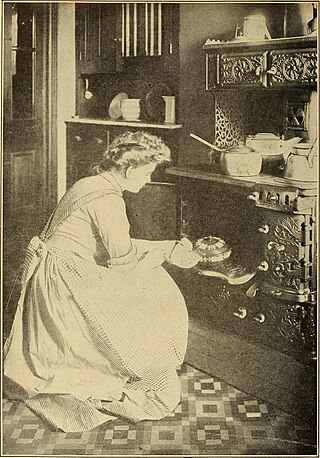
Gross domestic product (GDP) is a monetary measure of the market value of all the final goods and services produced in a specific time period by a country or countries. GDP is most often used by the government of a single country to measure its economic health. Due to its complex and subjective nature, this measure is often revised before being considered a reliable indicator.

Labour economics, or labor economics, seeks to understand the functioning and dynamics of the markets for wage labour. Labour is a commodity that is supplied by labourers, usually in exchange for a wage paid by demanding firms. Because these labourers exist as parts of a social, institutional, or political system, labour economics must also account for social, cultural and political variables.
A variety of measures of national income and output are used in economics to estimate total economic activity in a country or region, including gross domestic product (GDP), gross national product (GNP), net national income (NNI), and adjusted national income. All are specially concerned with counting the total amount of goods and services produced within the economy and by various sectors. The boundary is usually defined by geography or citizenship, and it is also defined as the total income of the nation and also restrict the goods and services that are counted. For instance, some measures count only goods & services that are exchanged for money, excluding bartered goods, while other measures may attempt to include bartered goods by imputing monetary values to them.

Homemaking is mainly an American and Canadian term for the management of a home, otherwise known as housework, housekeeping, housewifery or household management. It is the act of overseeing the organizational, day-to-day operations of a house or estate, and the managing of other domestic concerns. A person in charge of the homemaking, who is not employed outside the home, in the US and Canada, is called a homemaker, a term for a housewife or a househusband. Historically the role of homemaker was often assumed by women. The term "homemaker", however, may also refer to a social worker who manages a household during the incapacity of the housewife or househusband. Home health workers assume the role of homemakers when caring for elderly individuals. This includes preparing meals, giving baths, and any duties the person in need cannot perform for themselves.

An informal economy is the part of any economy that is neither taxed nor monitored by any form of government. Although the informal sector makes up a significant portion of the economies in developing countries, it is sometimes stigmatized as troublesome and unmanageable. However, the informal sector provides critical economic opportunities for the poor and has been expanding rapidly since the 1960s. Integrating the informal economy into the formal sector is an important policy challenge.

Feminist economics is the critical study of economics and economies, with a focus on gender-aware and inclusive economic inquiry and policy analysis. Feminist economic researchers include academics, activists, policy theorists, and practitioners. Much feminist economic research focuses on topics that have been neglected in the field, such as care work, intimate partner violence, or on economic theories which could be improved through better incorporation of gendered effects and interactions, such as between paid and unpaid sectors of economies. Other feminist scholars have engaged in new forms of data collection and measurement such as the Gender Empowerment Measure (GEM), and more gender-aware theories such as the capabilities approach. Feminist economics is oriented towards the goal of "enhancing the well-being of children, women, and men in local, national, and transnational communities."

In macroeconomics, the labor force is the sum of those either working or looking for work :

Genuine progress indicator (GPI) is a metric that has been suggested to replace, or supplement, gross domestic product (GDP). The GPI is designed to take fuller account of the well-being of a nation, only a part of which pertains to the size of the nation's economy, by incorporating environmental and social factors which are not measured by GDP. For instance, some models of GPI decrease in value when the poverty rate increases. The GPI separates the concept of societal progress from economic growth.

The Index of Sustainable Economic Welfare (ISEW) is an economic indicator intended to replace the gross domestic product (GDP), which is the main macroeconomic indicator of System of National Accounts (SNA). Rather than simply adding together all expenditures like the GDP, consumer spending is balanced by such factors as income distribution and cost associated with pollution and other unsustainable costs. The calculation excludes defence expenditures and considers a wider range of harmful effects of economic growth. It is similar to the genuine progress indicator (GPI).

The gross national income (GNI), previously known as gross national product (GNP), is the total domestic and foreign output claimed by residents of a country, consisting of gross domestic product (GDP), plus factor incomes earned by foreign residents, minus income earned in the domestic economy by nonresidents.
Productive and unproductive labour are concepts that were used in classical political economy mainly in the 18th and 19th centuries, which survive today to some extent in modern management discussions, economic sociology and Marxist or Marxian economic analysis. The concepts strongly influenced the construction of national accounts in the Soviet Union and other Soviet-type societies.
The System of National Accounts is an international standard system of national accounts, the first international standard being published in 1953. Handbooks have been released for the 1968 revision, the 1993 revision, and the 2008 revision. The System of National Accounts, in its various released versions, frequently with significant local adaptations, has been adopted by many nations. It continues to evolve and is maintained by the United Nations, the International Monetary Fund, the World Bank, the Organisation for Economic Co-operation and Development, and Eurostat.

A double burden is the workload of people who work to earn money, but who are also responsible for significant amounts of unpaid domestic labor. This phenomenon is also known as the Second Shift as in Arlie Hochschild's book of the same name. In couples where both partners have paid jobs, women often spend significantly more time than men on household chores and caring work, such as childrearing or caring for sick family members. This outcome is determined in large part by traditional gender roles that have been accepted by society over time. Labor market constraints also play a role in determining who does the bulk of unpaid work.
Family economics applies economic concepts such as production, division of labor, distribution, and decision making to the family. It is used to explain outcomes unique to family—such as marriage, the decision to have children, fertility, time devoted to domestic production, and dowry payments using economic analysis.

Unpaid labor or unpaid work is defined as labor or work that does not receive any direct remuneration. This is a form of non-market work which can fall into one of two categories: (1) unpaid work that is placed within the production boundary of the System of National Accounts (SNA), such as gross domestic product (GDP); and (2) unpaid work that falls outside of the production boundary, such as domestic labor that occurs inside households for their consumption. Unpaid labor is visible in many forms and isn't limited to activities within a household. Other types of unpaid labor activities include volunteering as a form of charity work and interning as a form of unpaid employment. In a lot of countries, unpaid domestic work in the household is typically performed by women, due to gender inequality and gender norms, which can result in high-stress levels in Women attempting to balance unpaid work and paid employment. In poorer countries, this work is sometimes performed by children.

Care work is a sub-category of work that includes all tasks that directly involve the care processes done in service of others. It is often differentiated from other forms of work because it is considered to be intrinsically motivated. This perspective defines care labor as labor done out of affection or a sense of responsibility for other people, with no expectation of immediate pecuniary reward. Regardless of motivation, care work includes care activities done for pay as well as those done without remuneration.
The social and economic changes in Thailand in the past decades have important implications for the quality and quantity of labor. The economic and non-economic roles of women in Thailand can be traced back several hundred years in Thai history, when there were traditional discriminatory attitudes towards women in the culture of Thailand. The transformation of Thailand's social and economic structure since the 1960s led to the gender disparities in Thai society. Recently, the position of Thai women in the labor market has improved a lot in comparison to the past as a result of modernization. In 2011, Thailand ranked 69th out of 143 countries in the Gender Inequality Index. In labor economics, gender inequality is widely discussed in terms of concepts of sex segregation and employment discrimination. Thai government and non-governmental organizations have put forth many policies and programs to address gender inequalities in the last few decades.
A moneyless economy or nonmonetary economy is a system for allocation of goods and services without payment of money. The simplest example is the family household. Other examples include barter economies, gift economies and primitive communism.
Digital labor or digital labour represents an emergent form of labor characterized by the production of value through interaction with information and communication technologies such as digital platforms or artificial intelligence. Examples of digital labor include on-demand platforms, micro-working, and user-generated data for digital platforms such as social media. Digital labor describes work that encompasses a variety of online tasks. If a country has the structure to maintain a digital economy, digital labor can generate income for individuals without the limitations of physical barriers.
Gross household product (GHP) is a specific estimation of the economic value added by the unpaid work and capital of households. It does not include many of the additional factors typically included in GPI determinations but focuses specifically on the "household economy". Per Jeremy Greenwood et al., GHP is overlooked by many people and seen as unimportant.











